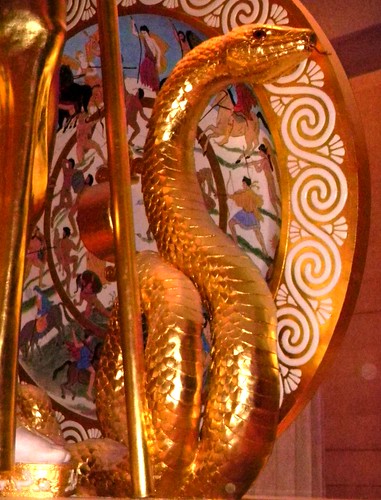
In 1997 the complex and difficult task of reconstructing six large bronze and wooden Roman banqueting beds, (Klinaii), copied and cast from the salvaged remains of beds recovered from the ancient Roman shipwreck at Mahdia in Tunisia, was undertaken, and completed by the workshops at the Bavarian State Collection of Prehistoric Artefacts, under the direction of Mr. Blumenau, the head of the workshop department. At his invitation, I had the privileged opportunity to privately view the completed project before the beds were dispersed to various museums and institutions.
For someone, like myself, fascinated by the neo-classical adaptations and dilutions of classical styles in furniture and architecture, especially during the late 18th and early 19th centuries, and despite the limited budget and the failure to finish the bronze components in the traditional black patina with silver and copper inlay, as was evident in the original pieces, the assembly of the six Klinaii presented a breathtaking visual feast of the most elegant, and yet powerfully imposing furniture I had ever seen. Inspired by the impact of seeing these reconstructions, I proceeded to investigate the possibilities of creating a small, and novel collection of furniture after ancient Greek examples, primarily remaining faithful to the original form, and using as far as is practicable authentic materials in its manufacture.
Having the good fortune of knowing Professor Dr. Wünschel, the curator and keeper of the Antikensammlung and Glyptotek in Munich, Germany, where I lived from 1987-2000, I obtained privileged access to one of the finest collections of ancient Greek ceramics, and Greek and Roman artefacts in the world, not to mention the use of these institutes libraries, and from these I drew most of my source material. One of my main literary sources, as has been for others in the past who have indulged in similar projects, was the extensive study of ancient furniture by G.M.A. Richter in her book The Furniture of the Greeks Etruscans and Romans published in 1966 (Phaidon Press). This work, a rewritten and revised version of an earlier book by the same author, Ancient Furniture (Clarendon Press 1926), provided an intricate and academic view of ancient furniture types and their uses. My intention has been, contrary to previous similar reconstructions by others, to produce uncompromising pieces that have not necessarily been adapted for modern use, but offer the owner of these pieces an opportunity to indulge in the theatre and novelty of their archaic use and appearance.
As is the case with most museum reconstructions that, due to the necessity of archaeological accuracy in the execution of the hitherto ancient and subsequently obscure and long lost methods of construction, have a tendency toward instability, it has been my aim to produce, with the benefit of modern skills and techniques, and the use of the best materials, solid and sturdy pieces of quality furniture, without compromising the form or proportion of those ancient objects that first offered inspiration. Most wooden and bronze components have been either finished in black or have received a darker patina in order to accentuate the siluette, but where a contrast of colour and material was warranted or deemed most attractive, the natural hue was enhanced and the surface finely polished.
As yet, the completed pieces include a Greek bronze and wooden Banqueting Table (Trapeza),a large wooden and leather Banqueting Couch (Kline), and a small selection of bronze and wooden Greek Stools (Diphroi).
Mark Harman Furniture.
Images and detailed descriptions of the pieces finished to date and the research material used, including my contact details are available on my website, http://www.markharmanfurniture.co.uk/